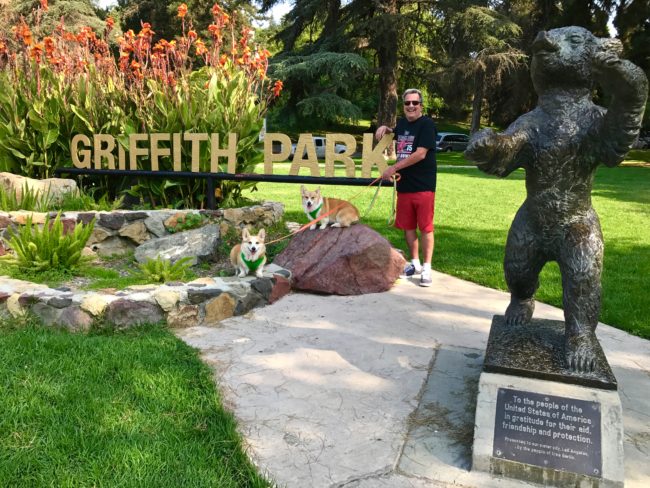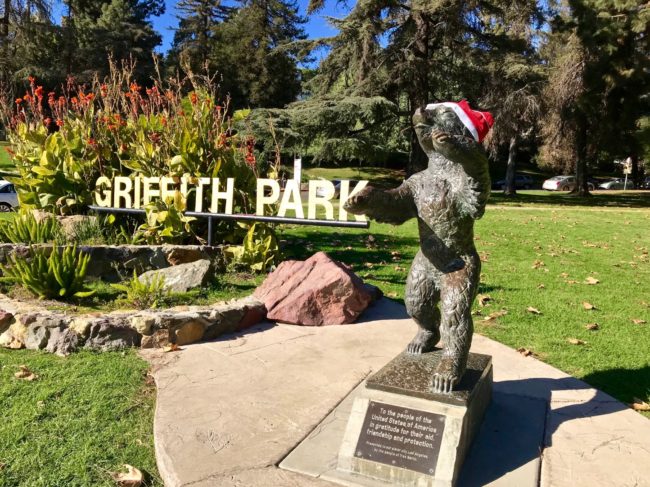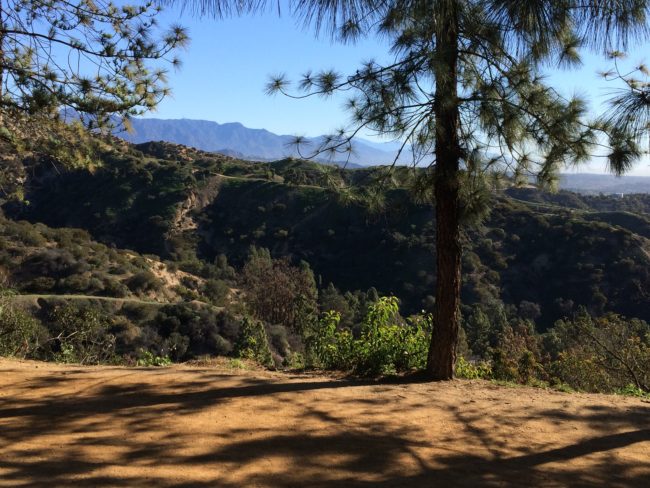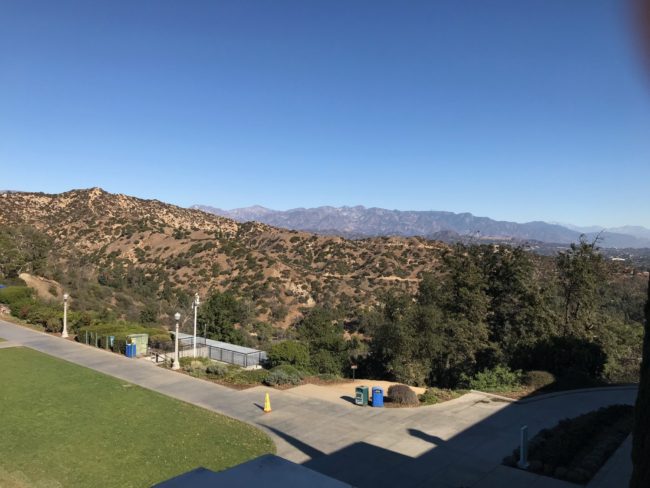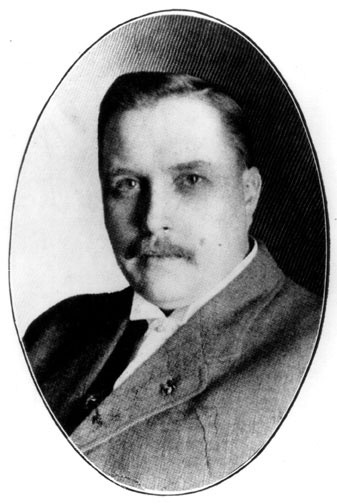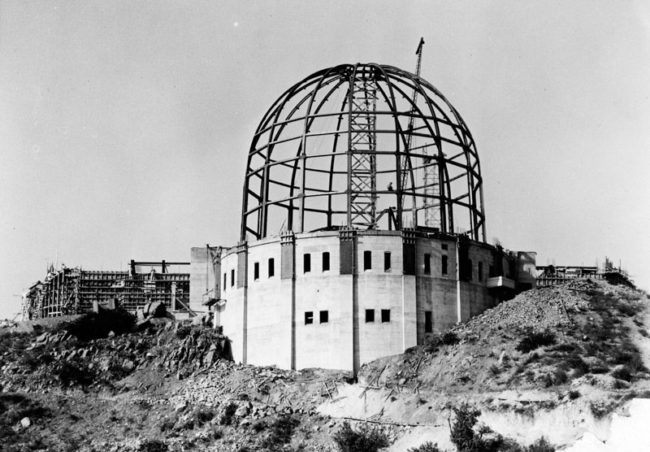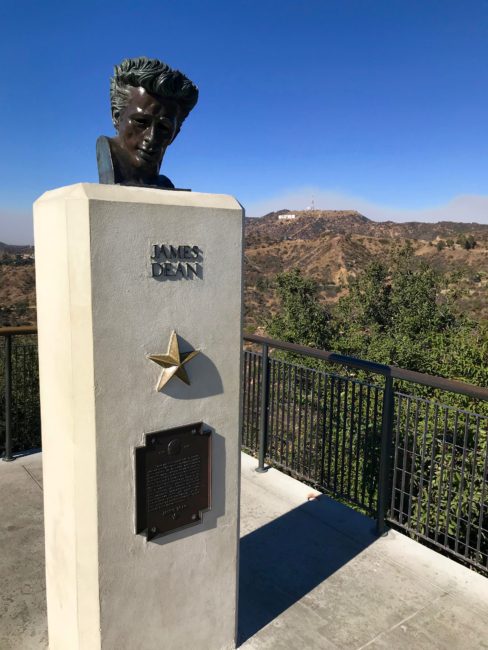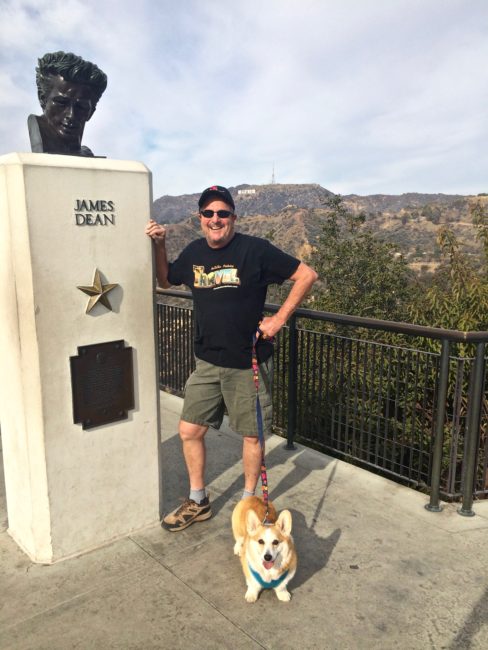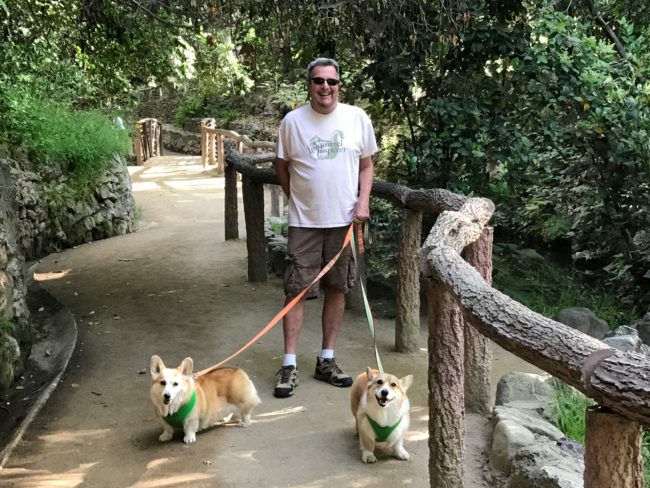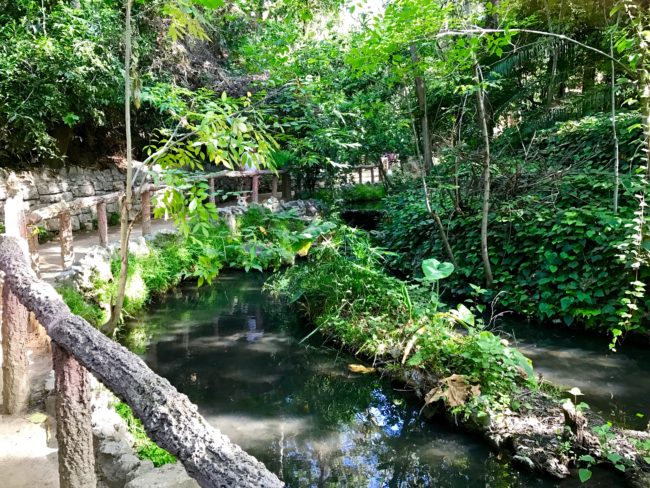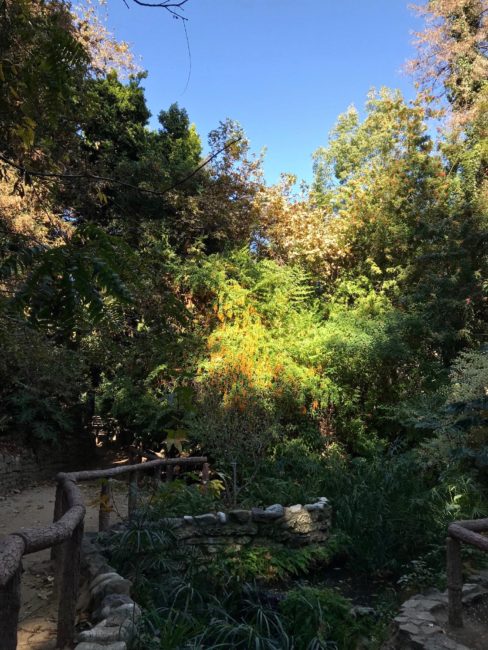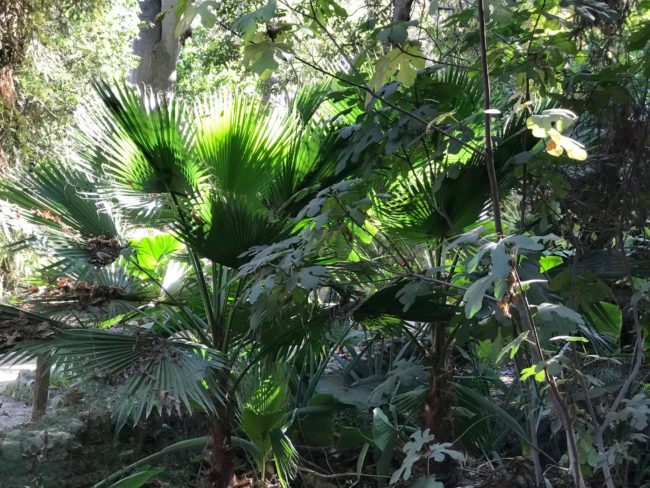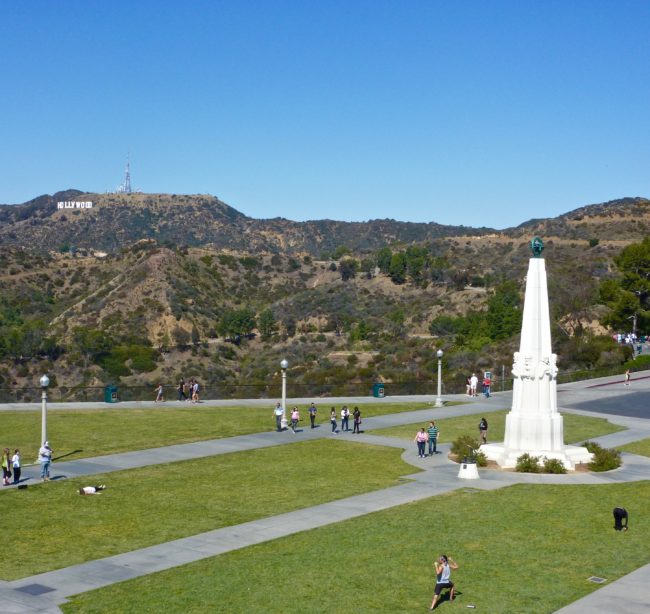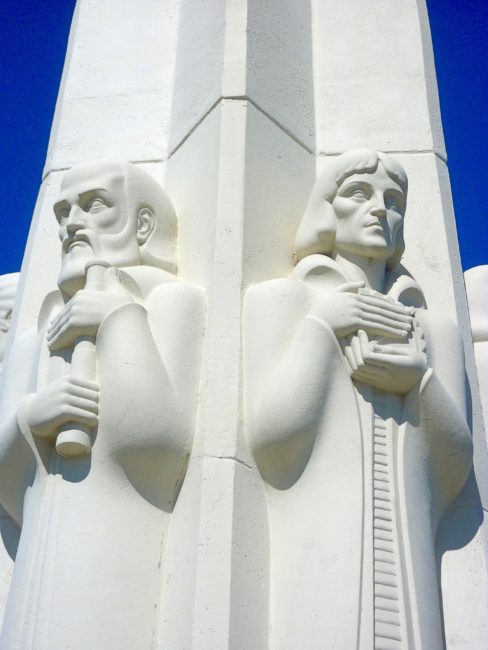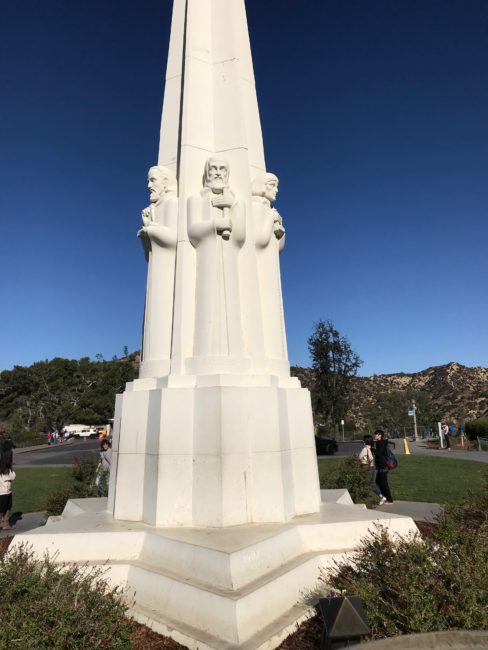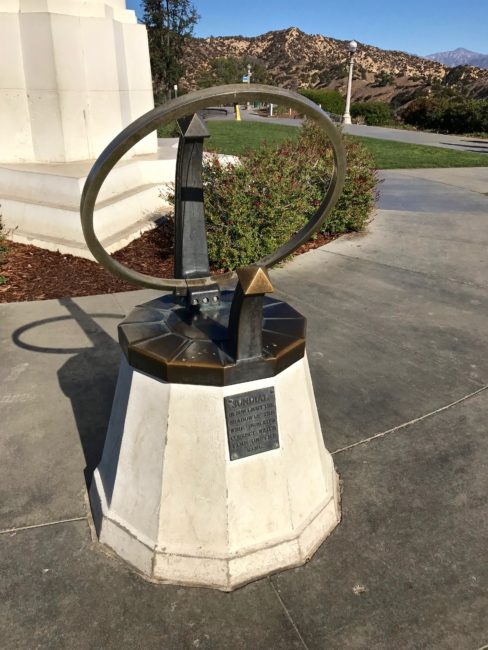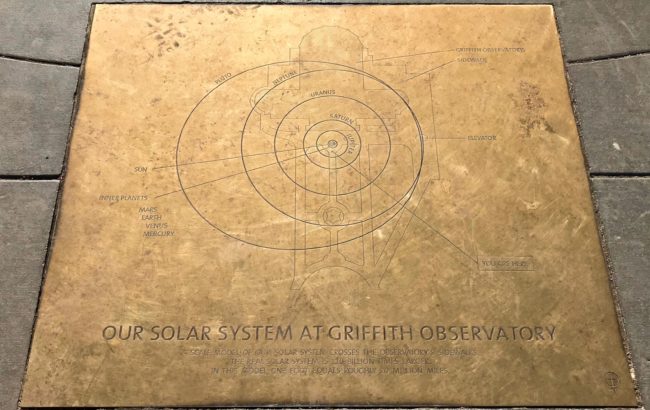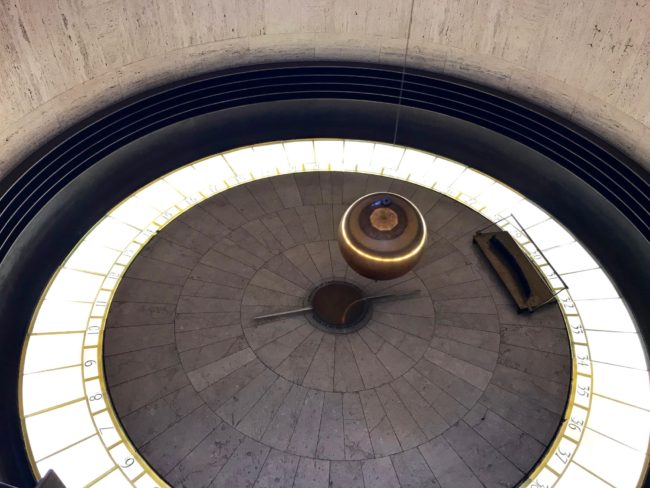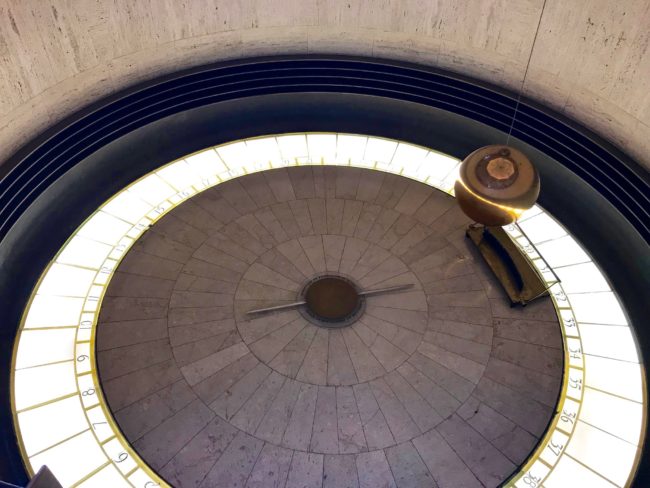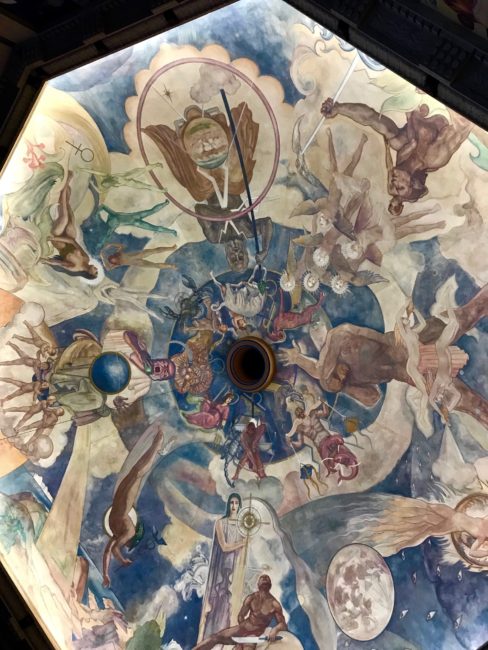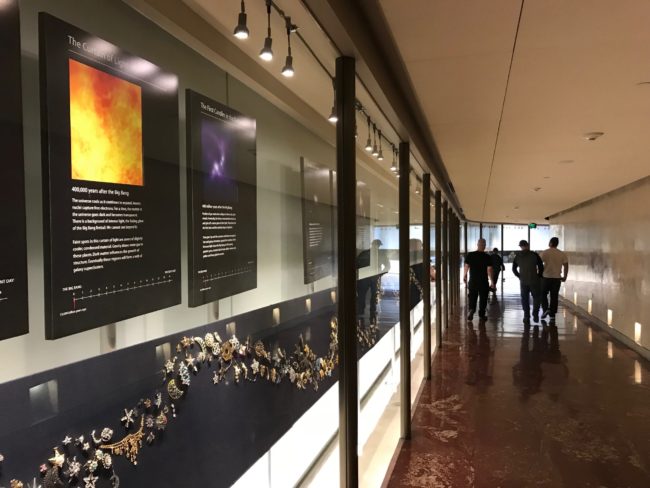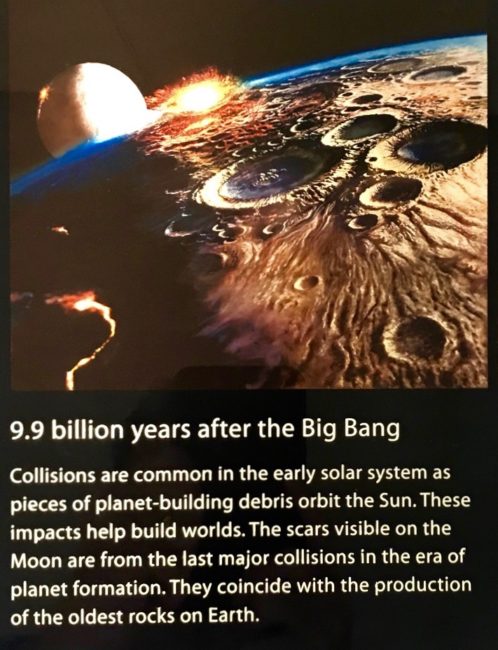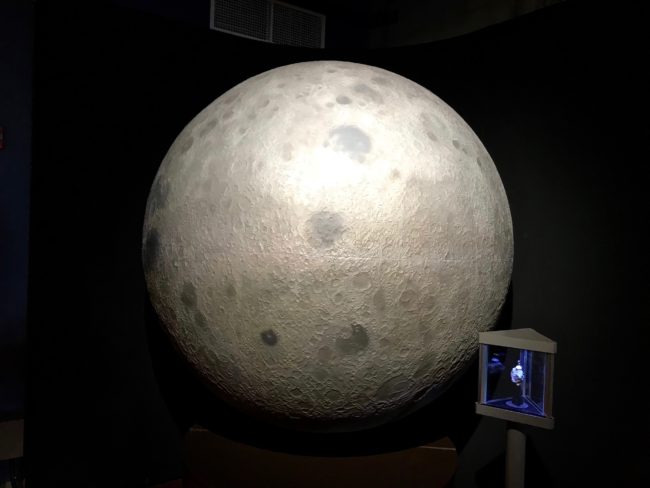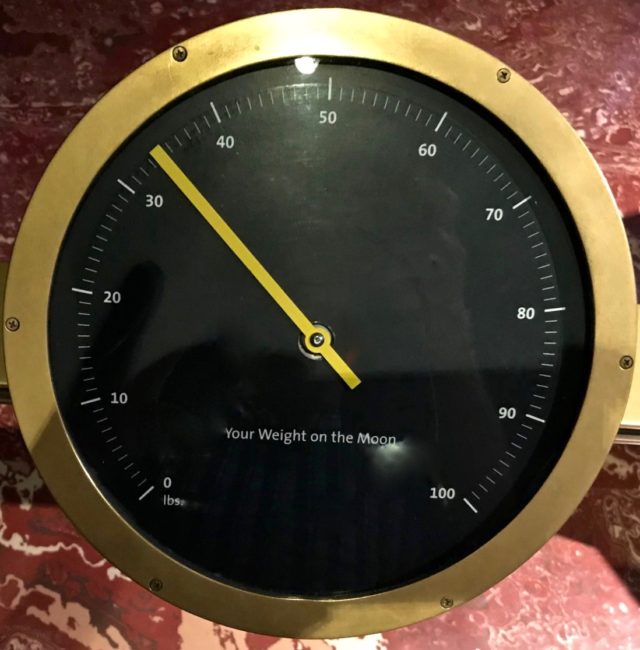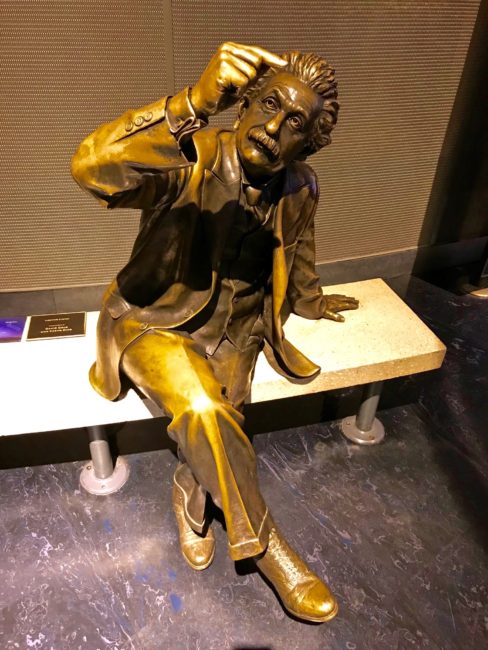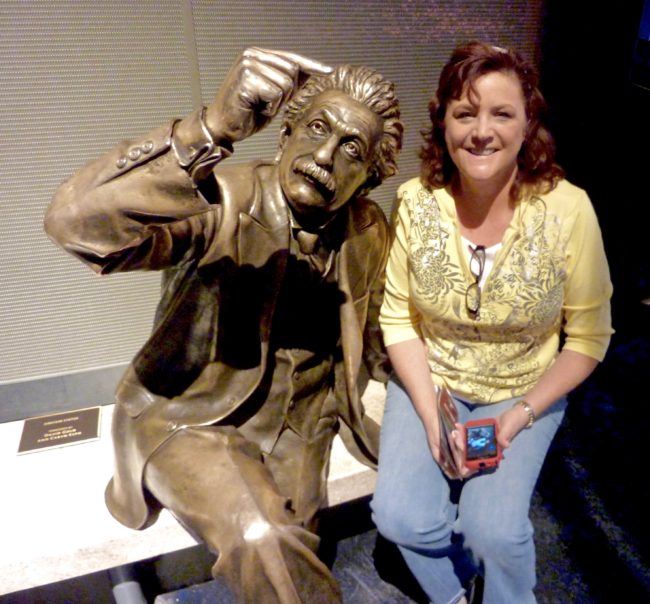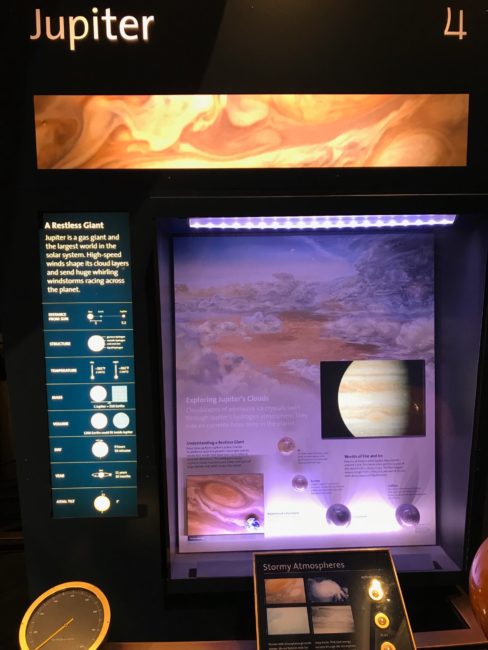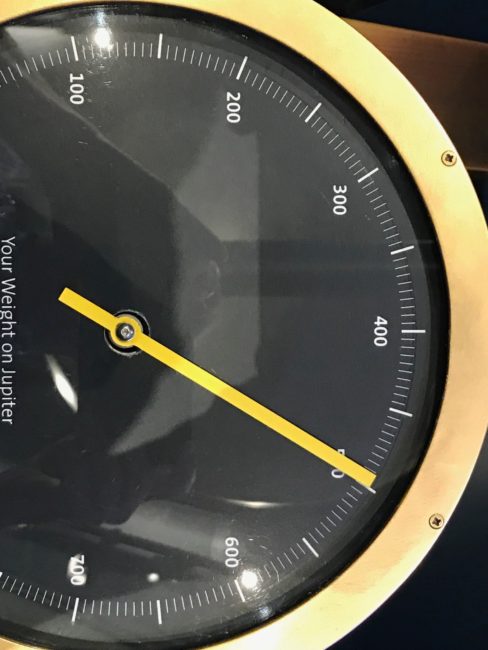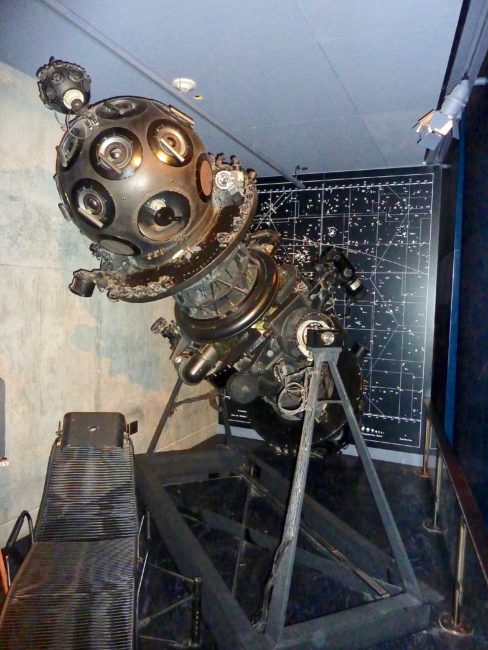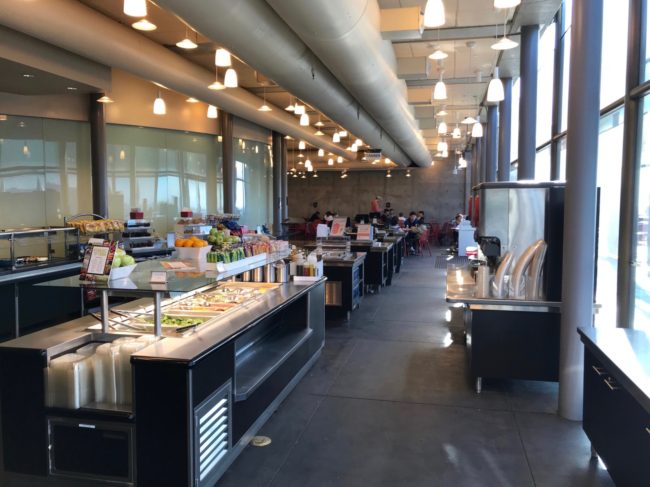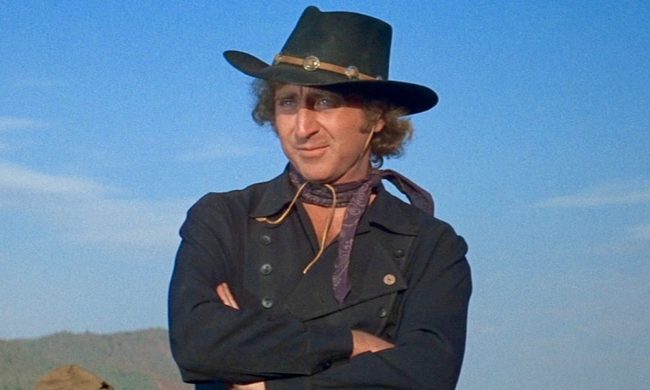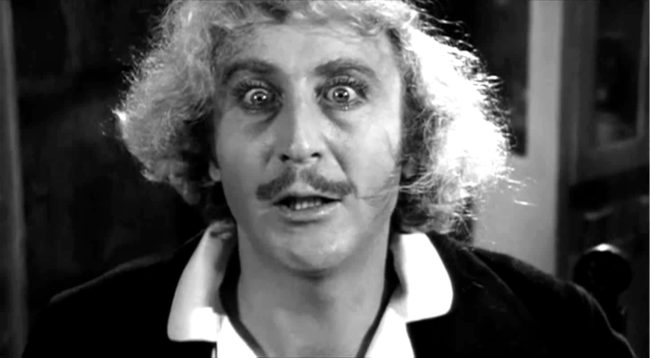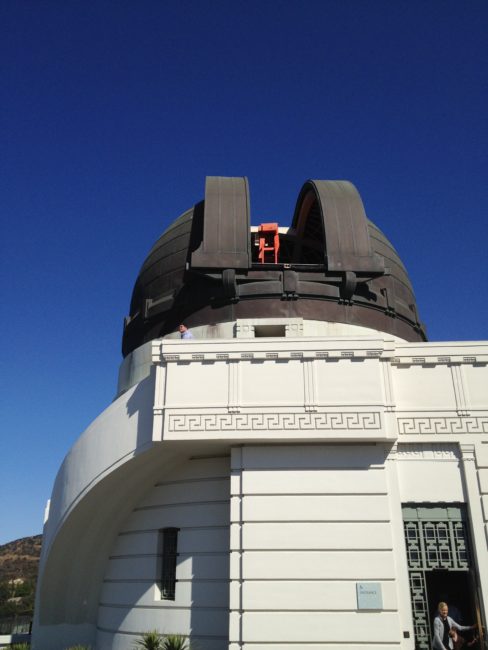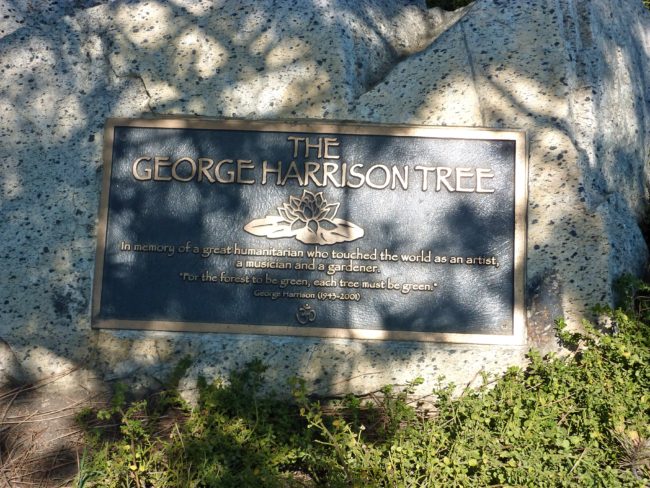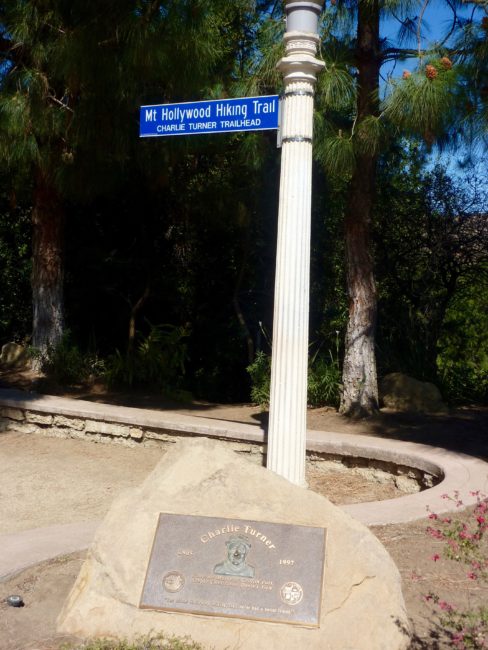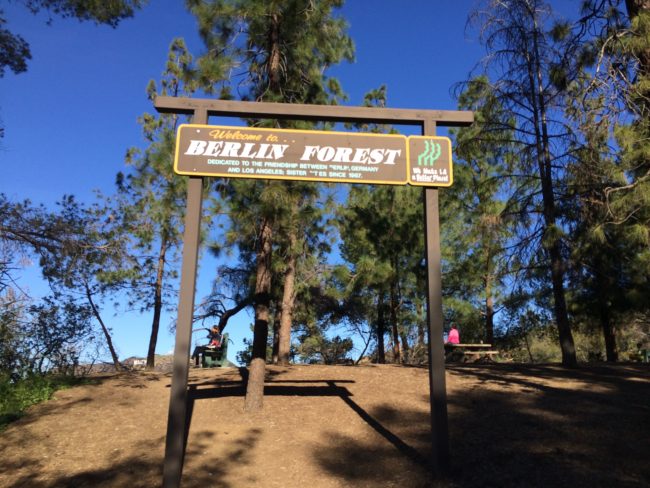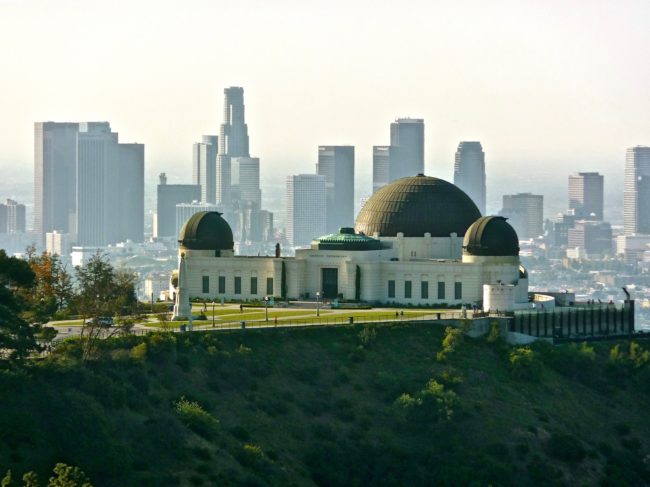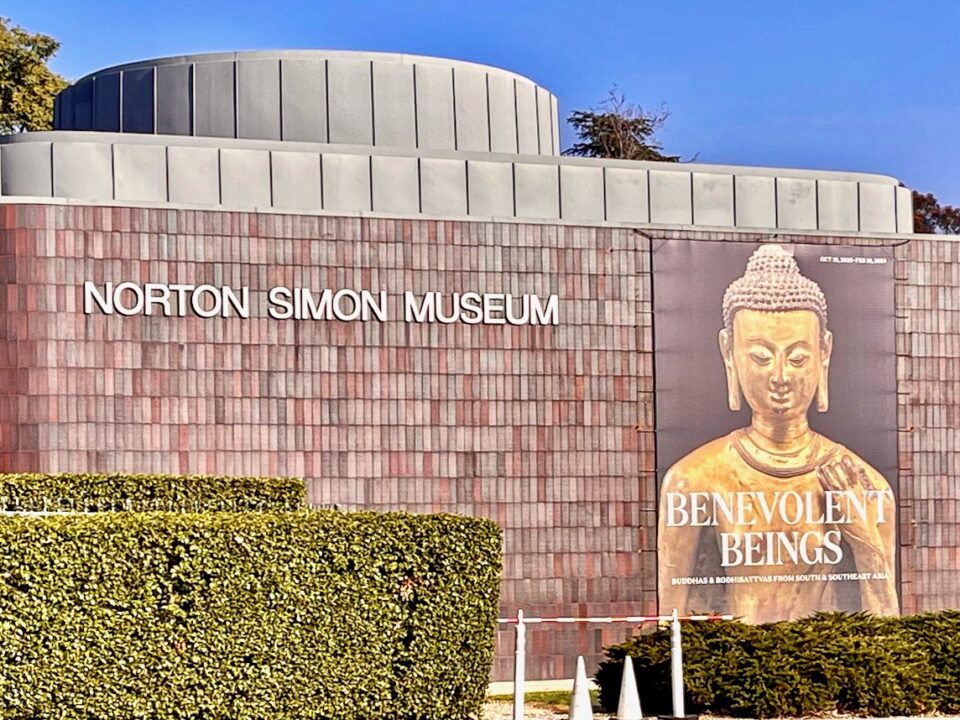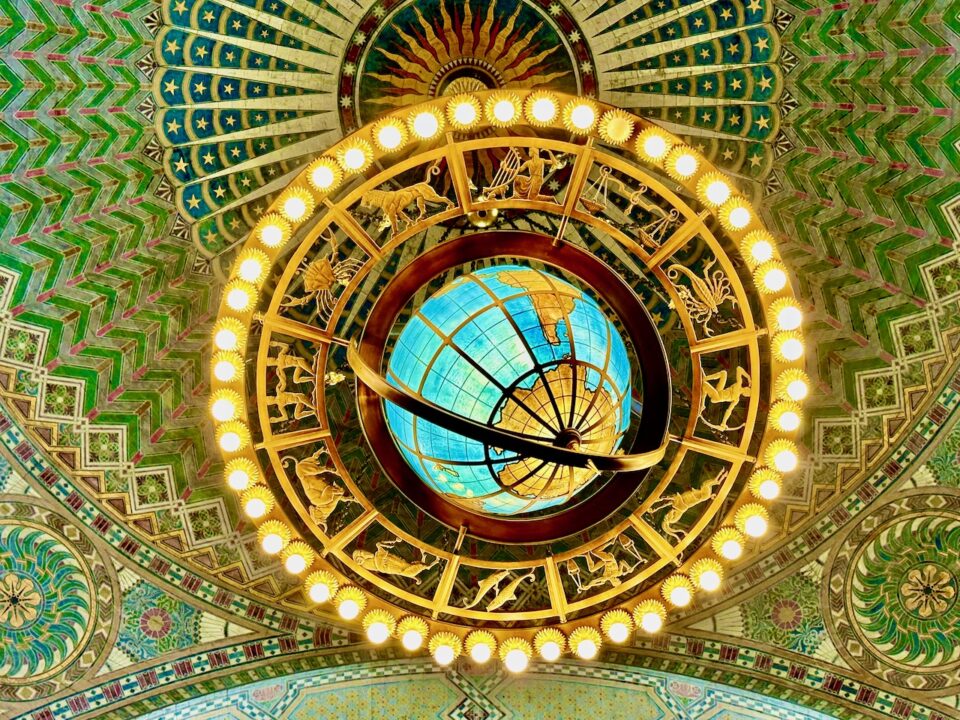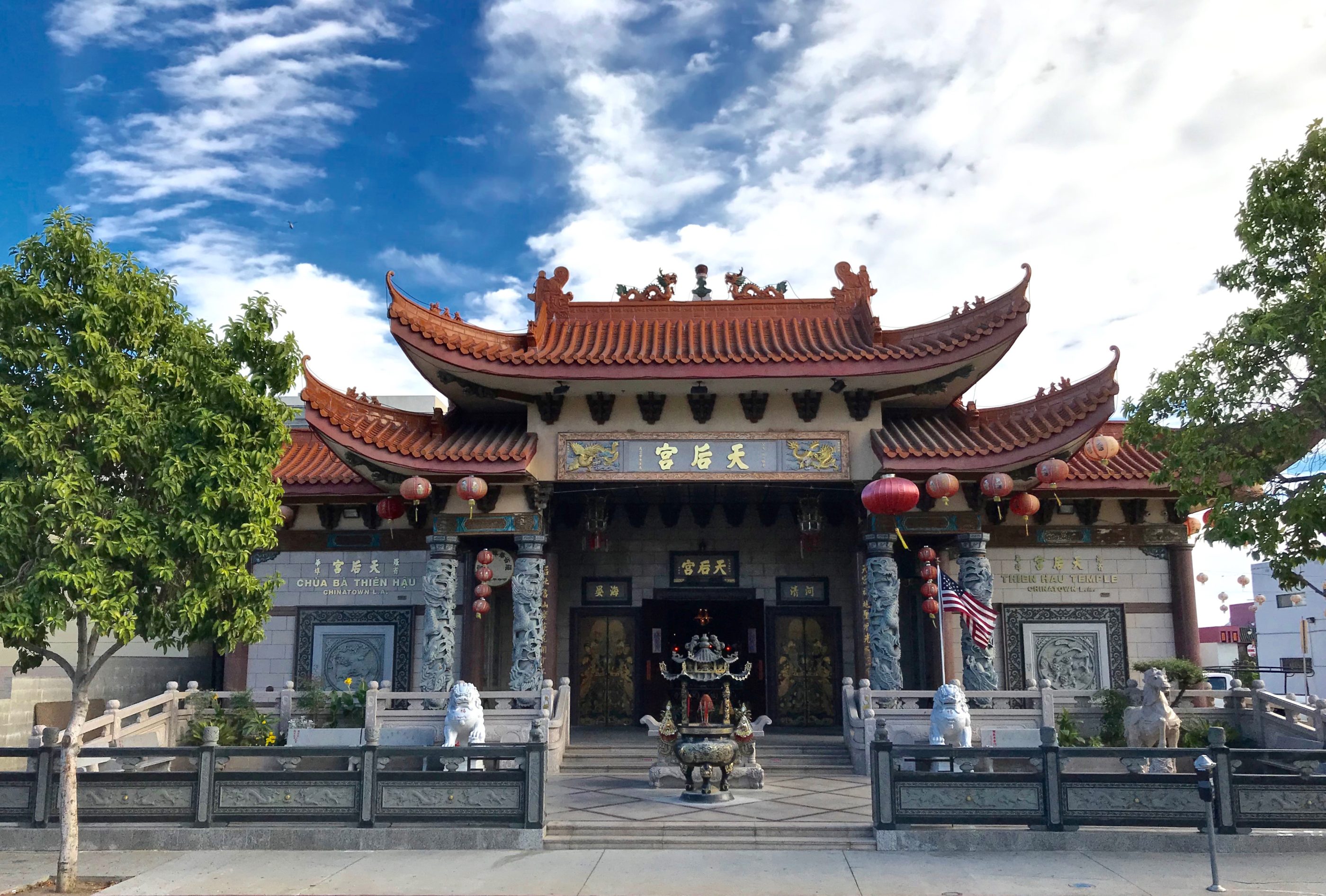
Thien Hau Temple – Los Angeles
November 10, 2017
Autry Museum of the American West – Griffith Park (Los Angeles)
January 31, 2018Star Trekking
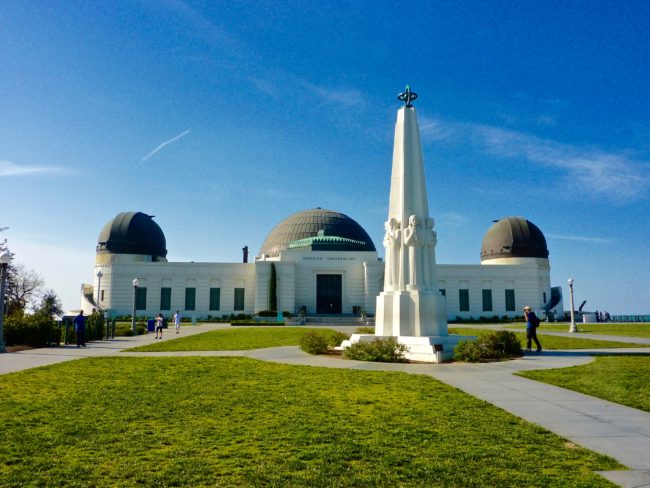 Griffith Observatory – Los Angeles
Griffith Observatory – Los Angeles
Visited: December 2017
If you want to see some real stars when you visit the Hollywood area, forget Hollywood; this place is it! The Griffith Observatory is one of Southern California’s most famous landmarks, and millions of visitors have gotten spaced out here out since it opened in 1935. It’s a short drive from Hollywood and is a fun, yet educational, spot to take in at day or night, especially when a celestial event is taking place.
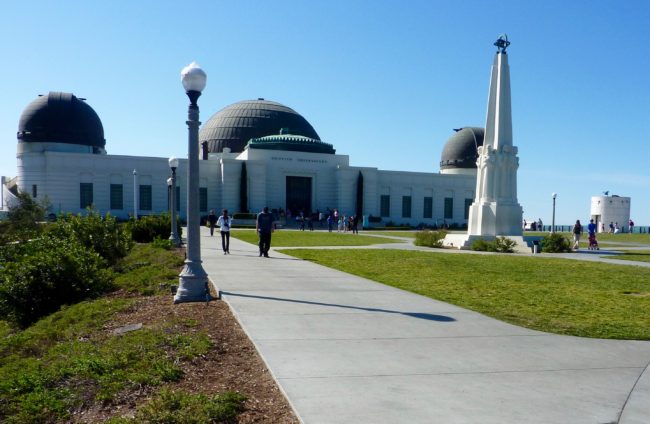 The land where Griffith Observatory sits was once a part of a Spanish settlement known as Rancho Los Felis. The property remained in the Felis family for more than a century and was subdivided through generations until Griffith J. Griffith (his parents must have had a weird sense of humor), a wealthy mining speculator who was born in Wales, purchased what remained of the rancho in 1882.
The land where Griffith Observatory sits was once a part of a Spanish settlement known as Rancho Los Felis. The property remained in the Felis family for more than a century and was subdivided through generations until Griffith J. Griffith (his parents must have had a weird sense of humor), a wealthy mining speculator who was born in Wales, purchased what remained of the rancho in 1882.
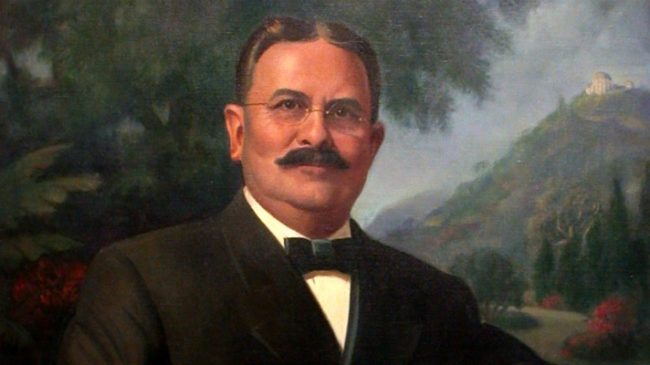 From the observatory website: “During a tour abroad, Griffith had discovered the great public parks of Europe and decided that his home, Los Angeles, would need a ‘Great Park’ for the public to become a great city.
From the observatory website: “During a tour abroad, Griffith had discovered the great public parks of Europe and decided that his home, Los Angeles, would need a ‘Great Park’ for the public to become a great city.
“On December 16, 1896, he donated 3,015 acres of Rancho Los Felis to the City of Los Angeles to create a public park in his name. “It must be made a place of rest and relaxation for the masses, a resort for the rank and file, for the plain people.” Griffith Park became the largest urban park in the U.S. with wilderness areas.”
He became interested in astronomy after numerous visits to the nearby Mount Wilson Observatory, and Griffith “offered the City of Los Angeles $100,000 for an observatory to be built on the top of Mount Hollywood to be fully owned and operated by the City of Los Angeles. Griffith’s plan for the observatory would include an astronomical telescope open to free viewing.” Griffith died in 1919. Understanding his vision would not be completed in his lifetime, he drafted a will “containing bequests for a public observatory and a Greek theatre,” where I’ve seen the Moody Blues on more than a few occasions.
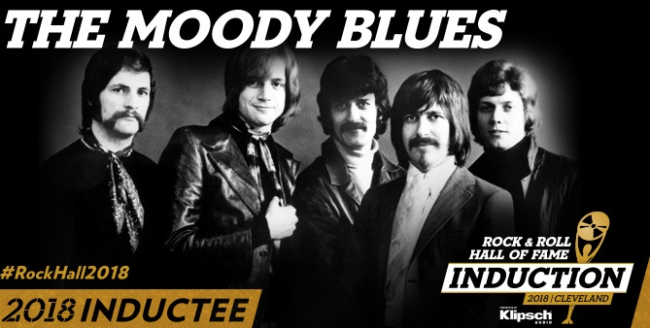 Digression: Griffith J. Griffith was involved in the first “Trial of the Century.” We heard this story on our tour of the Hollywood Forever Cemetery (the obelisk tomb is Griffith’s…with the observatory in the background).
Digression: Griffith J. Griffith was involved in the first “Trial of the Century.” We heard this story on our tour of the Hollywood Forever Cemetery (the obelisk tomb is Griffith’s…with the observatory in the background).
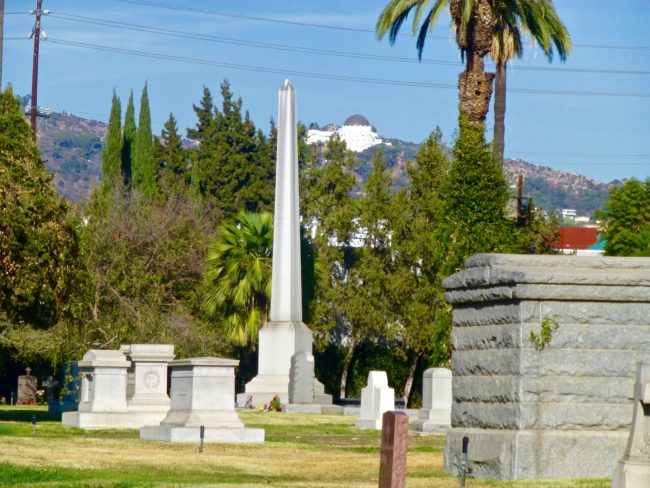 Griffith was vacationing in Santa Monica in September 1903. While staying in the presidential suite of the Arcadia Hotel, Griffith shot his wife in the face as she knelt on the floor. She lived but was severely disfigured and lost her right eye. Griffith was charged with assault with a deadly weapon with intent to commit murder. Henry T. Gage, the former governor of California, led the prosecution team. Griffith’s attorney’s cross-examination of the veiled Mrs. Griffith revealed that her husband, who was believed to be a teetotaler, was actually a closet drunk and “subject to paranoid delusions.” Griffith was unbelievably convicted of a lesser charge, assault with a deadly weapon. The judge sentenced him to two years in San Quentin State Prison, instructing that he be given “medical aid for his condition of alcoholic insanity.” Not surprisingly, this story is absent from the Griffith Observatory website.
Griffith was vacationing in Santa Monica in September 1903. While staying in the presidential suite of the Arcadia Hotel, Griffith shot his wife in the face as she knelt on the floor. She lived but was severely disfigured and lost her right eye. Griffith was charged with assault with a deadly weapon with intent to commit murder. Henry T. Gage, the former governor of California, led the prosecution team. Griffith’s attorney’s cross-examination of the veiled Mrs. Griffith revealed that her husband, who was believed to be a teetotaler, was actually a closet drunk and “subject to paranoid delusions.” Griffith was unbelievably convicted of a lesser charge, assault with a deadly weapon. The judge sentenced him to two years in San Quentin State Prison, instructing that he be given “medical aid for his condition of alcoholic insanity.” Not surprisingly, this story is absent from the Griffith Observatory website.
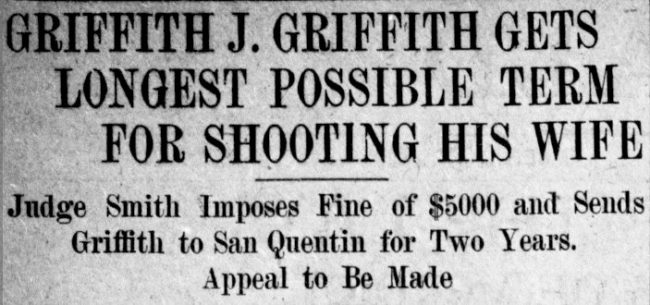 The preliminary plans for the observatory were drawn up by well known Caltech physicist Edward Kurth, who also guided the construction of the building. In May of 1931, the Griffith Trust and Los Angeles Park Commissioners selected architects John C. Austin (seen below…photo courtesy of Los Angeles Public Library) and Frederick M. Ashley to oversee the final plans for the new observatory building.
The preliminary plans for the observatory were drawn up by well known Caltech physicist Edward Kurth, who also guided the construction of the building. In May of 1931, the Griffith Trust and Los Angeles Park Commissioners selected architects John C. Austin (seen below…photo courtesy of Los Angeles Public Library) and Frederick M. Ashley to oversee the final plans for the new observatory building.
Russell W. Porter (below), who was known as the “Patron Saint of the amateur telescope-making movement,” worked with Kurth on the project. Kurth also never saw the grand opening, as he was killed in an automobile accident in February 1934, one year before the dedication and opening ceremonies in May 1935.
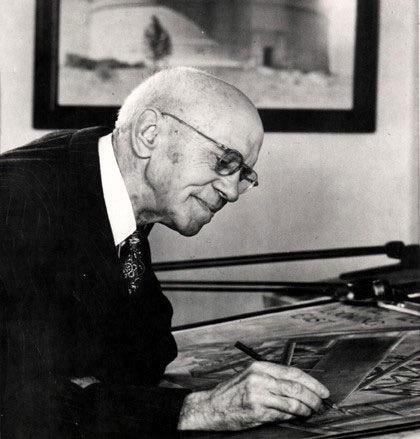 According to an architectural site I came upon, the Art Deco design mixes with elements of Moderne, Greek Revival, and Beaux-Arts architecture.
According to an architectural site I came upon, the Art Deco design mixes with elements of Moderne, Greek Revival, and Beaux-Arts architecture.
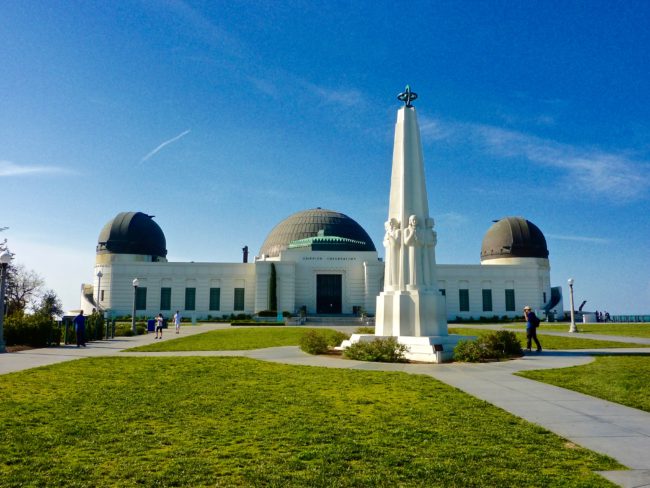 Tracy and I first visited the Griffith Observatory together in 2012 when it re-opened after its second major renovation. Recently, I decided to pay a return visit to see what’s happening in 2017. I drove up the winding road leading to the observatory, and even though it was 30 minutes before opening, the parking lot was nearly full (there’s lots of hiking in this area, too). The views from here stretch out to the ocean in one direction,
Tracy and I first visited the Griffith Observatory together in 2012 when it re-opened after its second major renovation. Recently, I decided to pay a return visit to see what’s happening in 2017. I drove up the winding road leading to the observatory, and even though it was 30 minutes before opening, the parking lot was nearly full (there’s lots of hiking in this area, too). The views from here stretch out to the ocean in one direction,
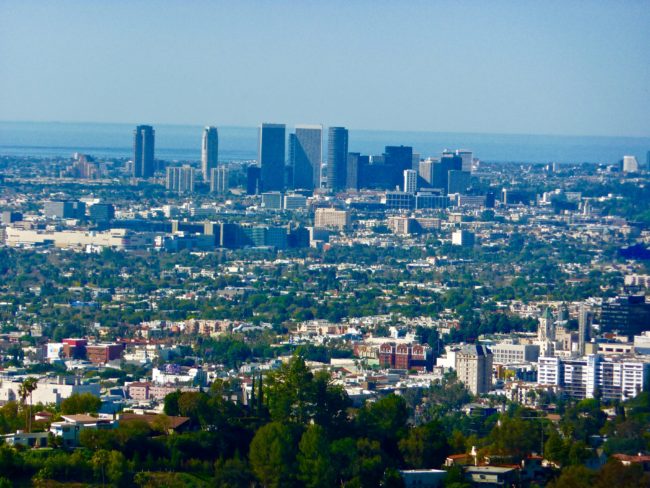 to views of the famed Hollywood Sign in another…
to views of the famed Hollywood Sign in another…
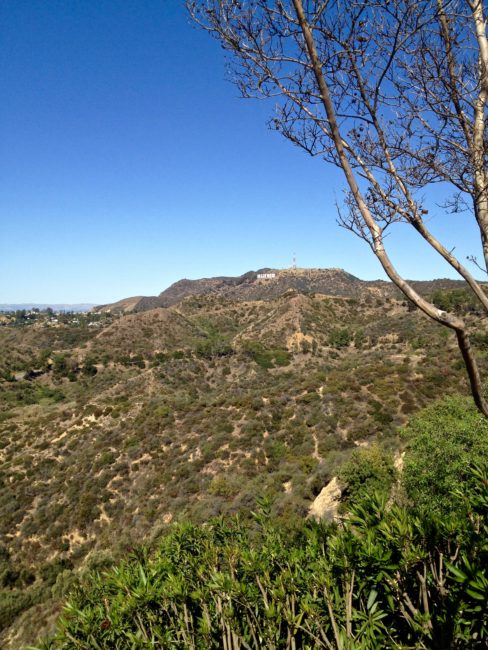 …and downtown Los Angeles (photos throughout this story are from a bunch of our visits through the years while hiking in the area).
…and downtown Los Angeles (photos throughout this story are from a bunch of our visits through the years while hiking in the area).
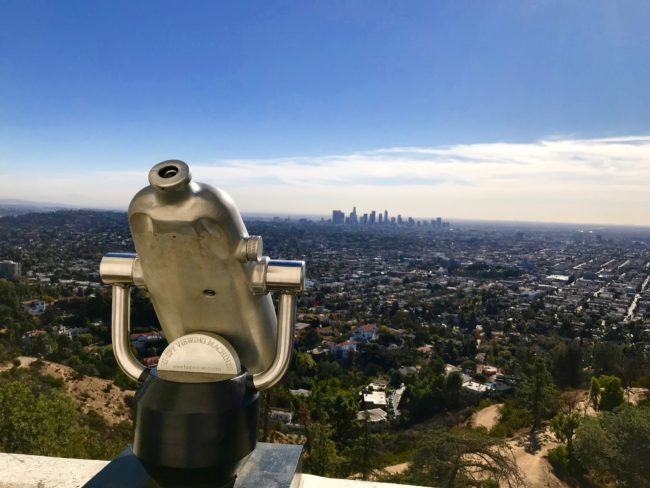 Numerous films have been shot at the observatory, including Rebel Without a Cause, the classic 1955 film about misunderstood youth, starring James Dean and Natalie Wood. There’s a bust of Dean outside the observatory.
Numerous films have been shot at the observatory, including Rebel Without a Cause, the classic 1955 film about misunderstood youth, starring James Dean and Natalie Wood. There’s a bust of Dean outside the observatory.
Admittance to the Griffith Observatory is free, and I recommend if you go on the weekend, you arrive there well before it opens at 10 because it gets crowded by about noon and parking is then relegated to the road where you have to take a hike to the observatory. (Opens at noon Tuesday – Friday. I also recommend you get here early on those days.)
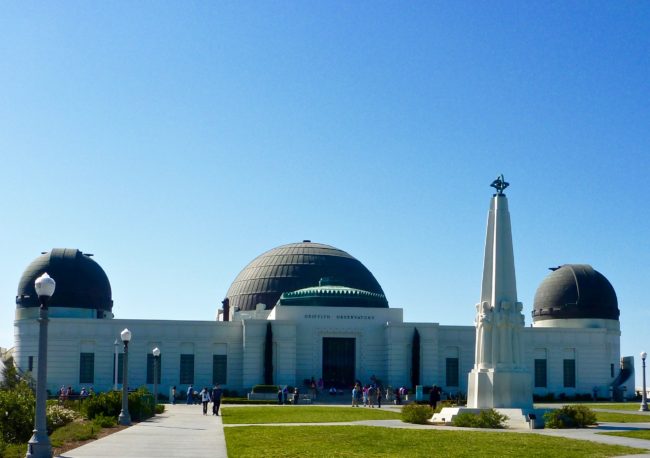 There were lots of people milling around the observatory before it opened. Many of those people include the hikers who walk up here on a 3 1/2 mile loop from the Fern Dell Trail (we like to do that with the Corgis). It’s a beautiful hike.
There were lots of people milling around the observatory before it opened. Many of those people include the hikers who walk up here on a 3 1/2 mile loop from the Fern Dell Trail (we like to do that with the Corgis). It’s a beautiful hike.
Digression 2: Frank Shearer was a famed “plantsman,” and in 1912 “he began planting native and imported ferns within a natural canyon nestled in the park’s southwestern quadrant that was once the Mococahuenga council grounds used by the Gabrielino Indians for tribal meetings. By the start of the 1920s the first of Fern Dell’s rustic bridges, footpaths and faux bois (French for “false wood”) features, designed by New Zealand landscape architects, the Montgomery Brothers, had been constructed.”
 Today, the 20-acre area with paths, ponds, and bridges is the only “public fern garden of its size and significance in California.”
Today, the 20-acre area with paths, ponds, and bridges is the only “public fern garden of its size and significance in California.”
I highly recommend hiking the Fern Dell trail, even if you don’t go up to the observatory. I can tell you that our corgis, even with their short legs are able to navigate the entire route (much better than their out-of-shape parents).
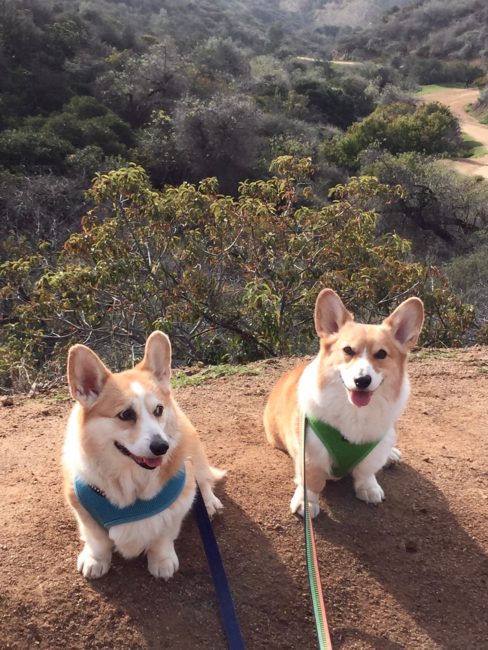 To get back to Fern Dell from the observatory, take the trail to the left of the observatory (as you face it), and you’ll get some cool views of the observatory.
To get back to Fern Dell from the observatory, take the trail to the left of the observatory (as you face it), and you’ll get some cool views of the observatory.
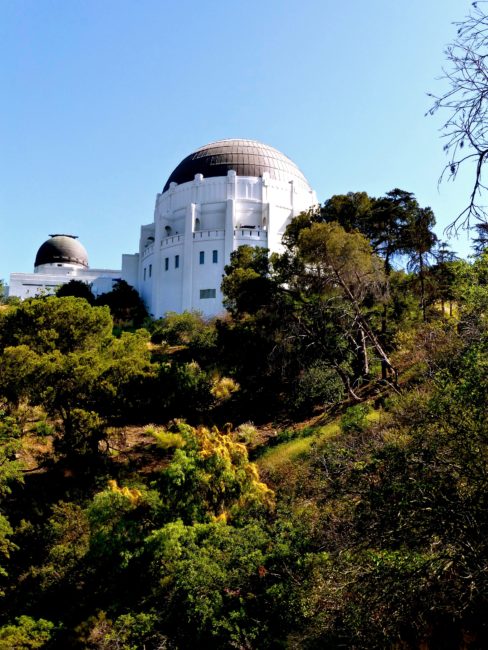 We take the loop in the opposite direction from most because this part of the hike is steeper, so I’d rather go down this side than up.
We take the loop in the opposite direction from most because this part of the hike is steeper, so I’d rather go down this side than up.
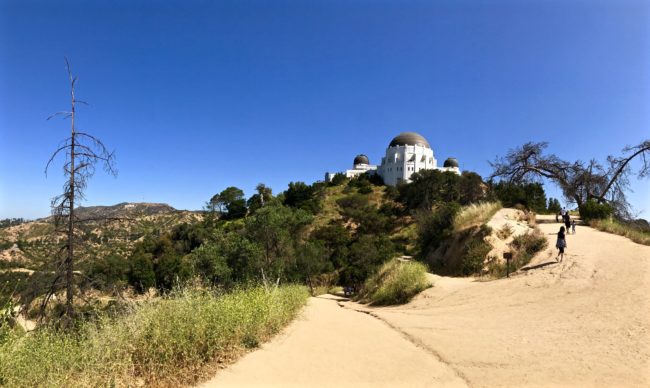 There are a few interesting sights to check out in front of the observatory before entering. First, I stopped by an obelisk (Astronomers Monument). The monument “pays homage to six of the world’s most famous astronomers Galileo, Copernicus, Kepler, Newton, Hipparchus, and Herschel.”
There are a few interesting sights to check out in front of the observatory before entering. First, I stopped by an obelisk (Astronomers Monument). The monument “pays homage to six of the world’s most famous astronomers Galileo, Copernicus, Kepler, Newton, Hipparchus, and Herschel.”
This was a “New Deal” project. Local artist Archibald Garner conceived the design who, along with five other artists sculpted the monument, with each one sculpting one of the astronomers. It was dedicated in November of 1934 (about six months before the opening of the Observatory).
In front of the Astronomers Monument is the Equatorial Sundial, made with high-nickel bronze. I assume this is how people gauged time before the iPhone. On the front sidewalk, just before you climb the steps to enter the observatory, check out the Solar System Lawn Model, which is a scale model of our solar system.
Now it was time to check out the observatory. If you arrive early, that’s the best time to purchase tickets for one of the Planetarium shows they present each hour. Ticket prices range from $3 to $7 for the shows in the Samuel Oschin Planetarium theater (comfy seats where you recline and listen to a live docent who tells story of stars and the universe), while the shows in the Leonard Nimoy Event Horizon presentation theater are free…a most logical choice.
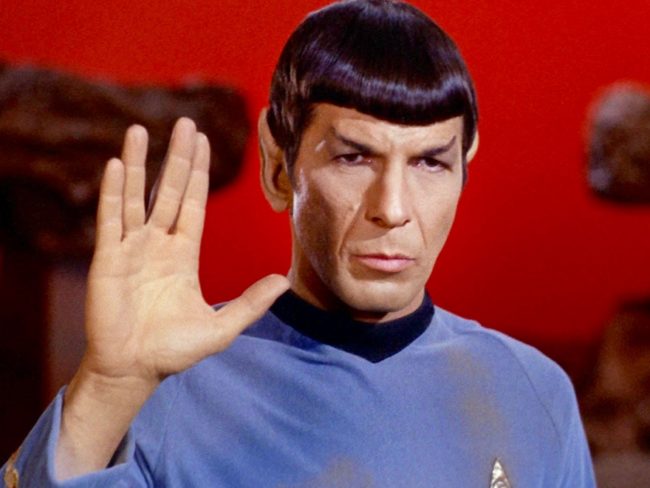 My suggestion is to arrive here when the observatory opens. When you step inside, you’ll be in the Central Rotunda, and there are some cool things to see in this room. The rotunda “celebrates the intersection of science and mythology, earth and sky.” Perhaps the most popular spot in the entire observatory is located in this room. As you can see, the first thing most people usually do when they enter is congregate around the Foucault Pendulum.
My suggestion is to arrive here when the observatory opens. When you step inside, you’ll be in the Central Rotunda, and there are some cool things to see in this room. The rotunda “celebrates the intersection of science and mythology, earth and sky.” Perhaps the most popular spot in the entire observatory is located in this room. As you can see, the first thing most people usually do when they enter is congregate around the Foucault Pendulum.
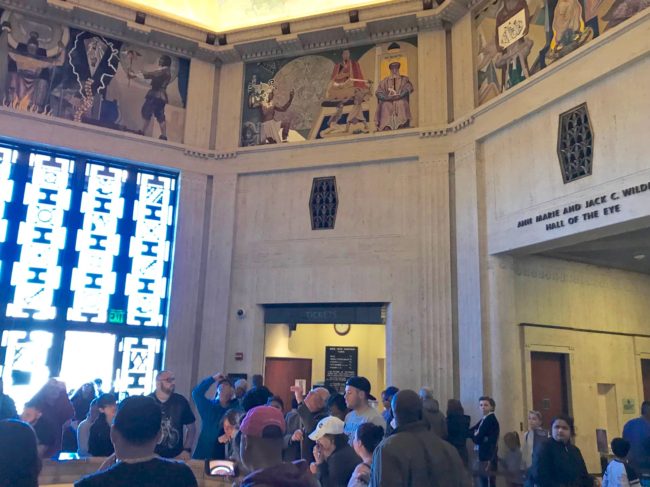 A favorite of visitors since the observatory opened, the 240-pound bronze ball suspended by a 40-foot cable “swings in a constant direction while the Earth turns beneath it.” For the patient among us, keep watching for a while as it knocks over pegs set up in the pendulum pit. The pit and the pendulum make for an interesting experience, as well as a good read.
A favorite of visitors since the observatory opened, the 240-pound bronze ball suspended by a 40-foot cable “swings in a constant direction while the Earth turns beneath it.” For the patient among us, keep watching for a while as it knocks over pegs set up in the pendulum pit. The pit and the pendulum make for an interesting experience, as well as a good read.
After looking down at the pendulum, raise your eyes to the colorful Ballin Ceiling Mural. In the 1930s, painter Hugo Ballin illustrated ancient stories of the sky. This ceiling tells stories of Atlas, Zeus, Mercury and even a woman holding the Star of Bethlehem.
Also in this room are the Ballin Wall Murals, Ballin’s attempt to “celebrate the progress of science through his spectacular art.
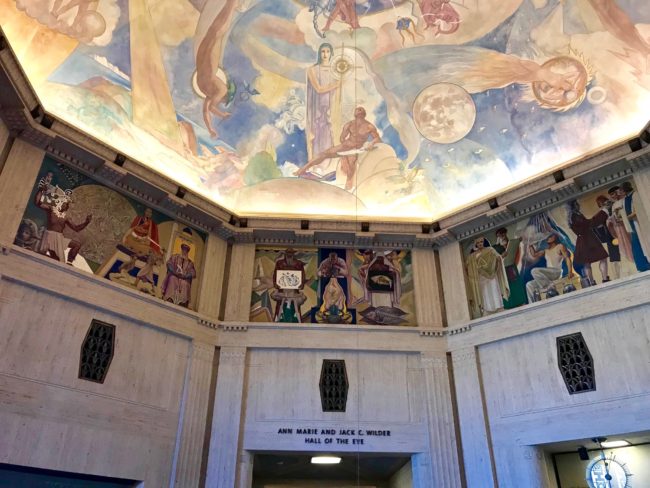 Each one shows how science and engineering changed throughout history up to the time Griffith Observatory opened to the public in 1935.”
Each one shows how science and engineering changed throughout history up to the time Griffith Observatory opened to the public in 1935.”
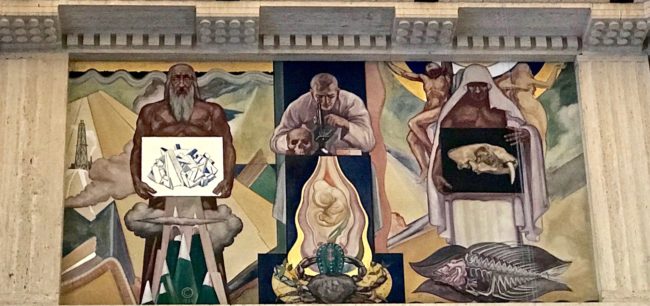 If you arrive early, here is my suggestion for visiting: Instead of seeing the rooms on the entrance floor (like most of the rest of the crowd), head downstairs and you should have virtually this entire space (pun very much intended) all to yourself. After walking down the stairs, I entered the Cosmic Collection, a long hallway explaining the history of the Universe starting with The Big Bang Theory (not the television show).
If you arrive early, here is my suggestion for visiting: Instead of seeing the rooms on the entrance floor (like most of the rest of the crowd), head downstairs and you should have virtually this entire space (pun very much intended) all to yourself. After walking down the stairs, I entered the Cosmic Collection, a long hallway explaining the history of the Universe starting with The Big Bang Theory (not the television show).
I found myself in the Edge of Space area, and more specifically the Pieces of the Sky that feature some very large meteorites. The 183-pound Bruceville Meteorite was found by a farmer as he plowed a field near Sacramento. It traveled to earth thousands of years ago.
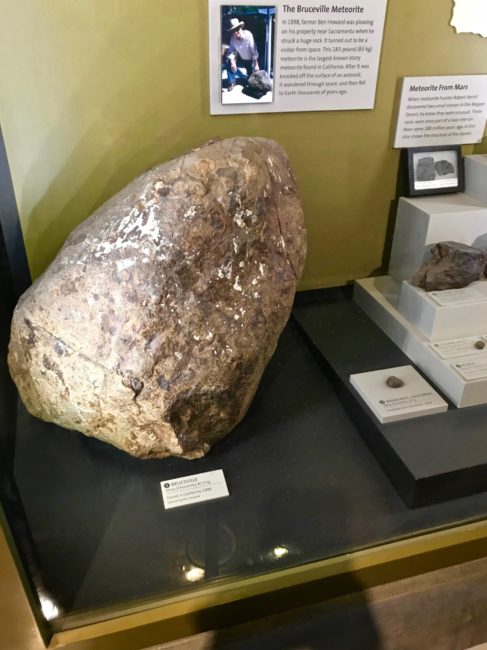 Even more impressive is the 395-pound Iron Meteorite that fell from the skies in the Arizona desert about 50,000 years ago. It created a 4,200 foot in diameter crater.
Even more impressive is the 395-pound Iron Meteorite that fell from the skies in the Arizona desert about 50,000 years ago. It created a 4,200 foot in diameter crater.
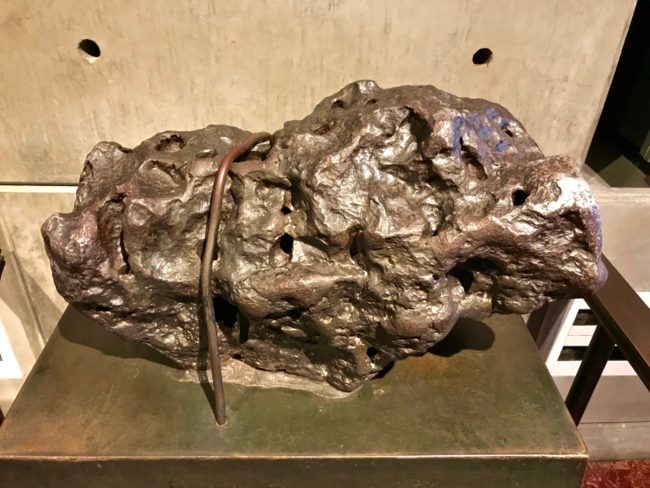 Not seen on my recent visit here was this photo that adorned the wall in this area back in 2012. As you can see, this Alabama woman made dubious history when she became the “first person documented to have been struck by a meteorite.” That’s one way you can get a piece of the rock.
Not seen on my recent visit here was this photo that adorned the wall in this area back in 2012. As you can see, this Alabama woman made dubious history when she became the “first person documented to have been struck by a meteorite.” That’s one way you can get a piece of the rock.
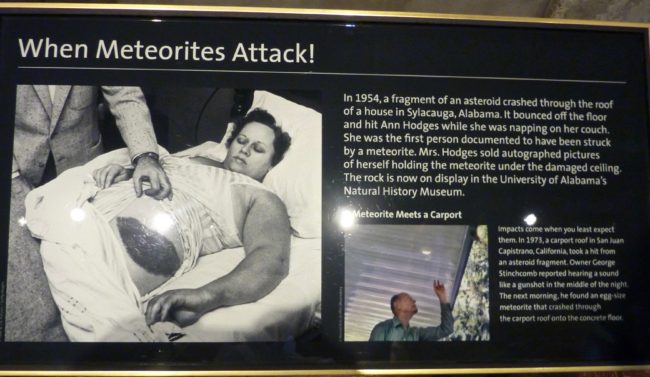 The Griffith Observatory boasts The Big Picture...“the largest astronomical image ever put on display.” On this floor, I took a look through one of the many observing telescopes, which “enables visitors on the Edge of Space mezzanine to use simple Observing Telescopes mounted 60 feet away to explore objects in greater detail.”
The Griffith Observatory boasts The Big Picture...“the largest astronomical image ever put on display.” On this floor, I took a look through one of the many observing telescopes, which “enables visitors on the Edge of Space mezzanine to use simple Observing Telescopes mounted 60 feet away to explore objects in greater detail.”
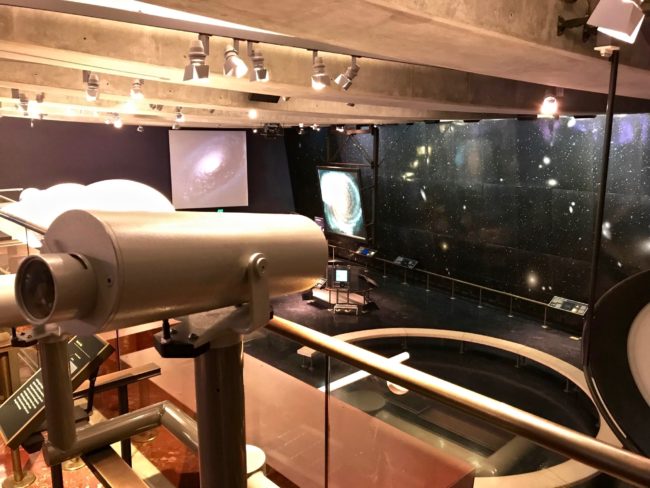 Then it was off to The Moon, where I learned about our closest neighbor and also what my weight would be on the moon’s surface. I stood on a scale that showed me on the moon I would weigh a mere 35 pounds (no Jenny Craig needed there).
Then it was off to The Moon, where I learned about our closest neighbor and also what my weight would be on the moon’s surface. I stood on a scale that showed me on the moon I would weigh a mere 35 pounds (no Jenny Craig needed there).
Next, I was now inside the Gunther Depths of Space Exhibit. I ran into an old friend of ours who we met in 2012. Tracy thought it might be her cousin, and I quickly realized her theory of relativity was not quite up to Albert Einstein’s, although I heard when he presented it, someone yelled out, “It’s about time!” Interestingly, Einstein was initially going to be one of the people carved on the Astronomer’s Monument in front of the observatory. However, the planners felt it would be inappropriate to feature someone who was still alive.
It was time to learn about The Planets. While reading about each planet, I weighed myself to see what I would weigh on each one.
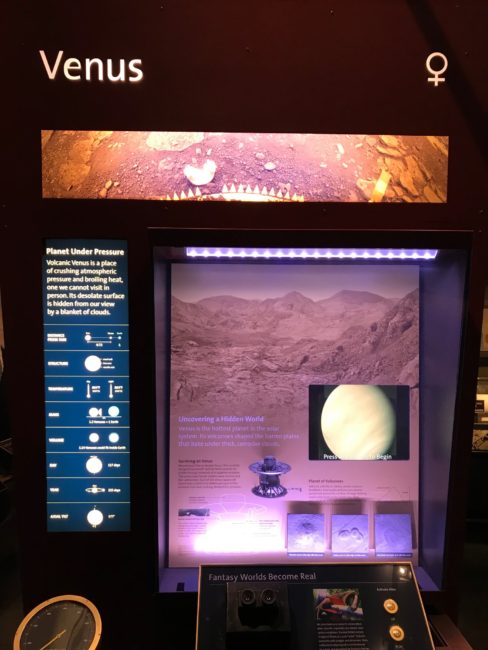 For instance, on Mercury I weighed 85 pounds, on Venus I weighed 160 pounds, while on Jupiter I weighed nearly 500 pounds, which coincidentally was my actual weight after this past Thanksgiving dinner.
For instance, on Mercury I weighed 85 pounds, on Venus I weighed 160 pounds, while on Jupiter I weighed nearly 500 pounds, which coincidentally was my actual weight after this past Thanksgiving dinner.
In a little room, I saw the Zeiss Mark IV planetarium projector. It was used at Griffith Observatory from 1964 to 2002. The planetarium theater was actually used to help astronauts “practice their stellar navigation skills.”
After checking out the gift shop (that might be a good present for Tracy) and the Cafe At The End of the Universe…
…I headed back up to the level where I entered the Wilder Hall of the Eye.
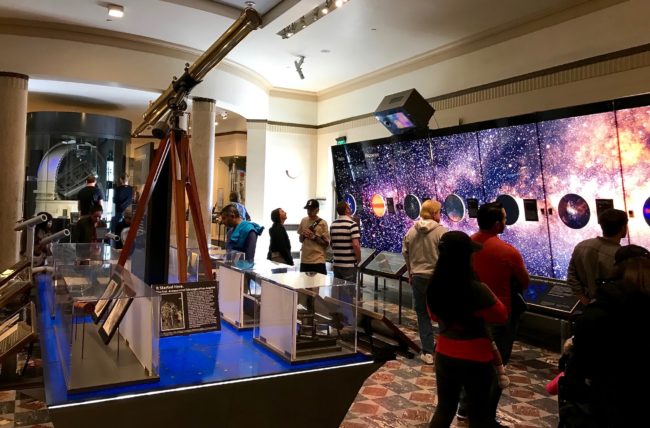 I kept looking for Blazing Saddles and Young Frankenstein memorabilia but to no avail.
I kept looking for Blazing Saddles and Young Frankenstein memorabilia but to no avail.
I took a quick look at the Camera Obscura that “enables visitors on the Edge of Space mezzanine to use simple Observing Telescopes mounted 60 feet away to explore objects in greater detail.”
Besides being an instrumental part of Bohemian Rhapsody by Queen, Galileo, among other things, mapped the moon’s surface and discovered the moons of Jupiter. It was in this area where I encountered The First Astronomical Telescope of Los Angeles. It was made by the John Byrne Company of New York in 1888, and its first owner was a retired physician and former State Senator.
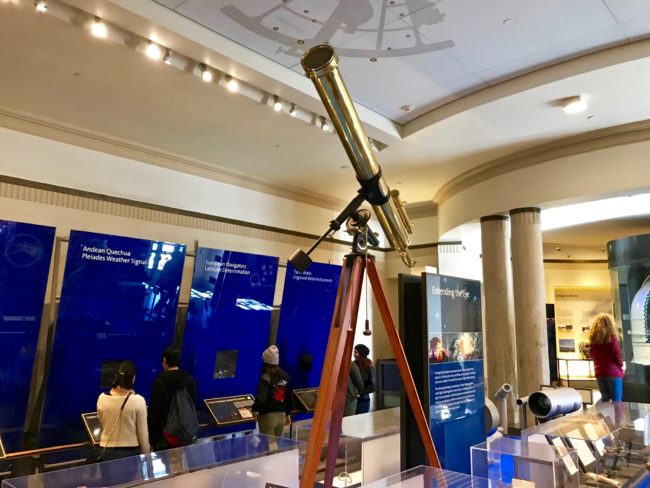 There are other interesting artifacts and displays in this room, including a full-scale replica of America’s First Satellite, Explorer 1, which launched from Cape Canaveral in 1958.
There are other interesting artifacts and displays in this room, including a full-scale replica of America’s First Satellite, Explorer 1, which launched from Cape Canaveral in 1958.
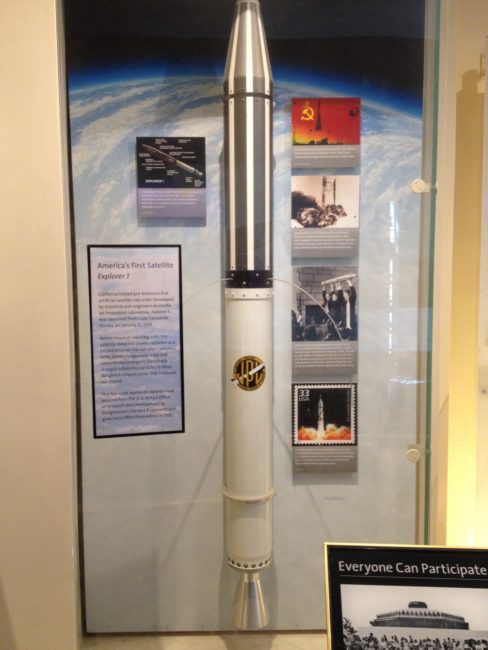 I heard they were going to have a Tesla demonstration, and although I can’t afford one, I was excited to see it. Unfortunately, the demonstration wouldn’t take place for nearly another hour, and it was actually Nikola Tesla’s coil that we use to bring electricity to our homes which would be demonstrated. I never witnessed that current event.
I heard they were going to have a Tesla demonstration, and although I can’t afford one, I was excited to see it. Unfortunately, the demonstration wouldn’t take place for nearly another hour, and it was actually Nikola Tesla’s coil that we use to bring electricity to our homes which would be demonstrated. I never witnessed that current event.
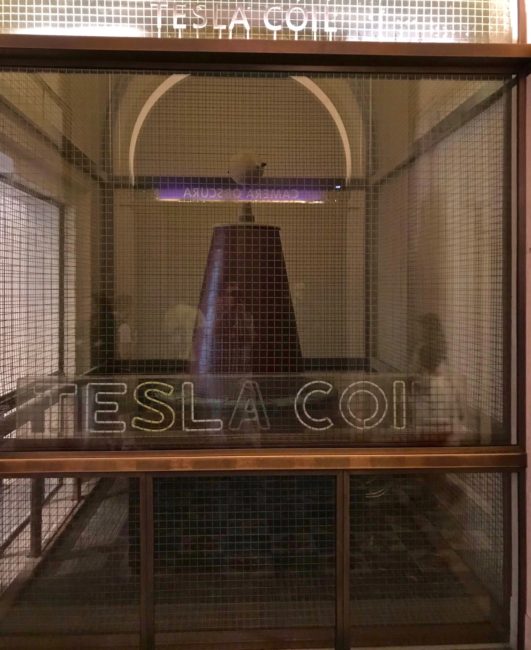 I walked back under the Ballin Ceiling and entered the final part of my inside journey in the Ahmanson Hall of The Sky Exhibits. Gazing at the Phases of the Moon display, I thought back to my childhood when, for a moment, I dreamed of becoming an astronomer. However, just like the moon, it was the only phase I was going through.
I walked back under the Ballin Ceiling and entered the final part of my inside journey in the Ahmanson Hall of The Sky Exhibits. Gazing at the Phases of the Moon display, I thought back to my childhood when, for a moment, I dreamed of becoming an astronomer. However, just like the moon, it was the only phase I was going through.
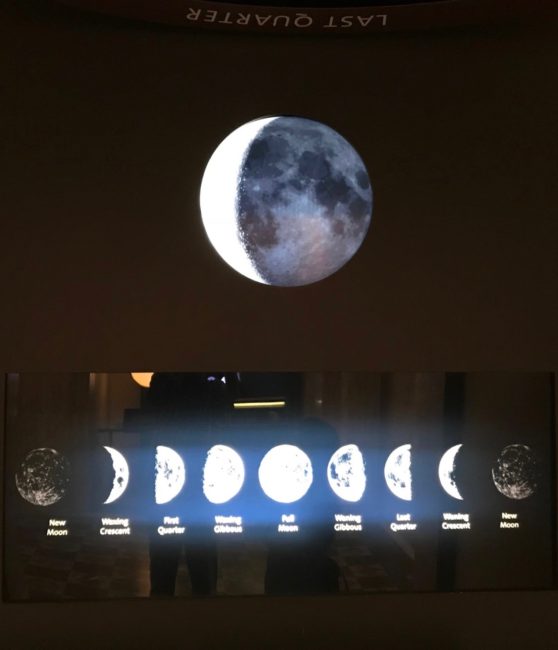 In the final room, a colorful case displayed a number of elements. I looked at it for about a minute before realizing I was out of my elements.
In the final room, a colorful case displayed a number of elements. I looked at it for about a minute before realizing I was out of my elements.
It wasn’t the only colorful exhibit in the room.
 I wandered in this room where one can view “three solar telescopes in this room use light coming through the coelostat in the dome overhead to provide live views of the constantly changing Sun.” I stepped outside, climbed the stairs to the top, where I saw the Coelostat (solar telescope) Dome.
I wandered in this room where one can view “three solar telescopes in this room use light coming through the coelostat in the dome overhead to provide live views of the constantly changing Sun.” I stepped outside, climbed the stairs to the top, where I saw the Coelostat (solar telescope) Dome.
Many times you can get some pretty great views from up here…
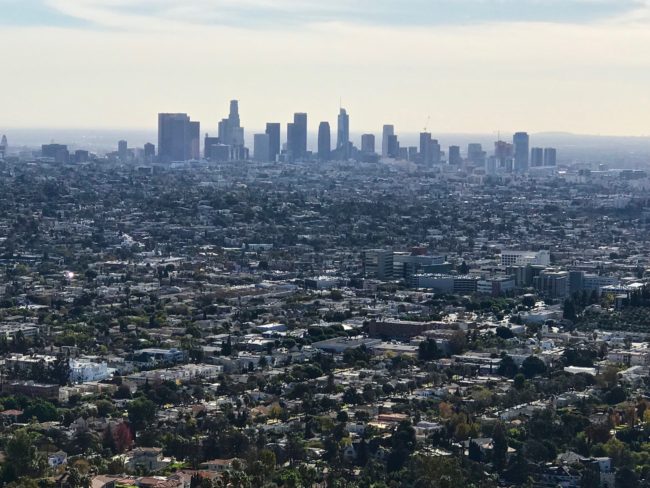 …however when I visited last week the fires ravaging Southern California made for some smoky vistas from here…
…however when I visited last week the fires ravaging Southern California made for some smoky vistas from here…
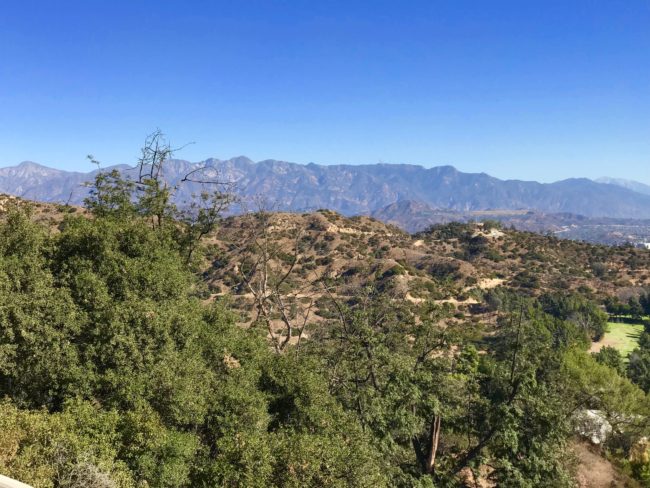 …and especially from near the James Dean monument toward the Hollywood sign.
…and especially from near the James Dean monument toward the Hollywood sign.
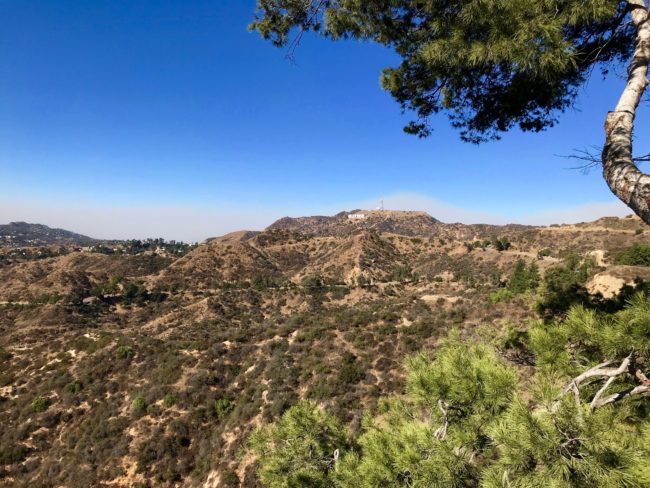 My last stop at the observatory was the Zeiss Telescope. According to the website, ”Since opening in 1935, more than seven million people have put an eye to Griffith Observatory’s original 12-inch Zeiss refracting telescope. More people have looked though it than any other telescope in the world.”
My last stop at the observatory was the Zeiss Telescope. According to the website, ”Since opening in 1935, more than seven million people have put an eye to Griffith Observatory’s original 12-inch Zeiss refracting telescope. More people have looked though it than any other telescope in the world.”
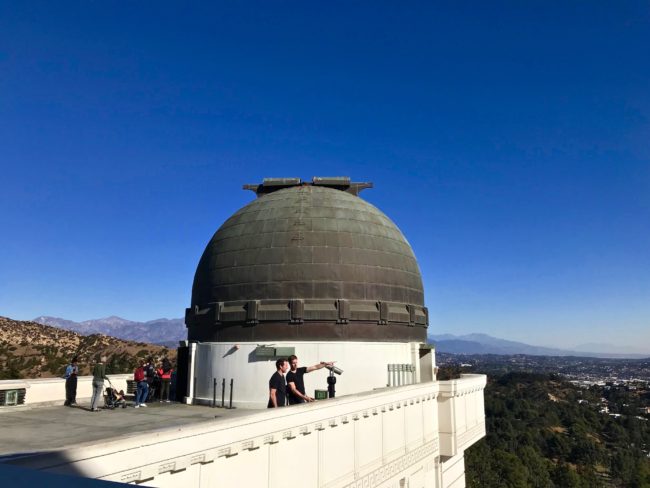 When there are special celestial events, this is the place to go.
When there are special celestial events, this is the place to go.
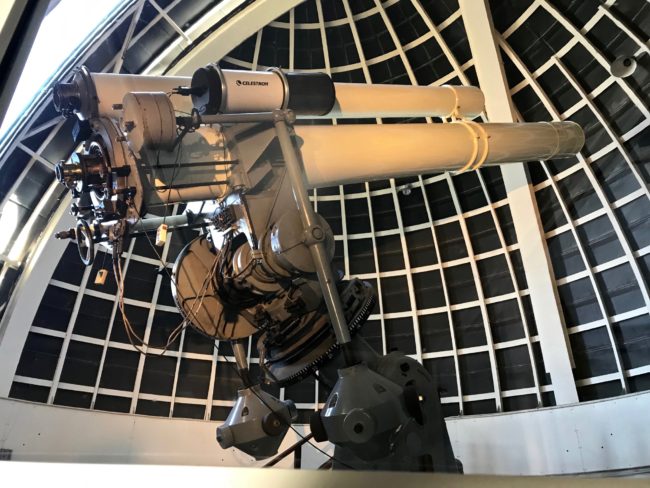 If not you can still check out the telescope like I did…but not look through it.
If not you can still check out the telescope like I did…but not look through it.
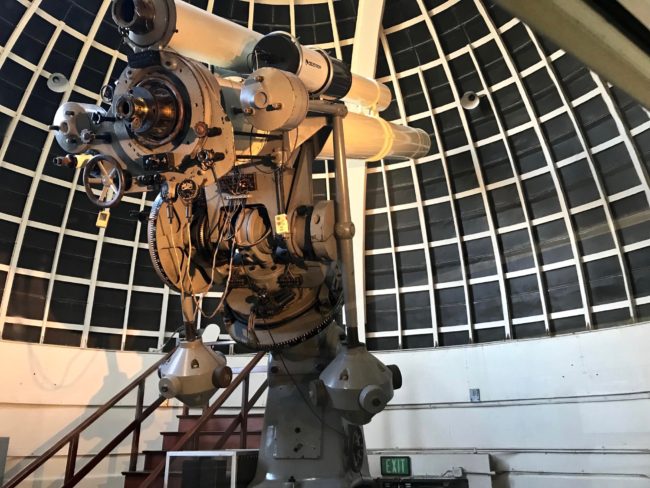 That concluded my observatory self-guided tour.
That concluded my observatory self-guided tour.
Back in 2012, as we headed toward our parked our car, near the edge of the parking lot, we saw a tree. But this was not just any tree. This was the George Harrison Tree…whether it “gently weeps,” I did not know. However it was Something to see. (photo below is from our 2012 trip).
Digression: On February 22, 2004, the City of Los Angeles declared George Harrison Day. A plaque was unveiled at the base of the George Harrison Tree in Griffith Park. (Note…in June 2014, the George Harrison tree was declared dead. The irony…it had been destroyed by beetles…can’t make this stuff up). A Yew tree, less susceptible to insects, now stands in its place. Hopefully, they’ll never have to find another yew. (Photo from The Guardian of the new tree planting)
 From here, you can also hike the Mount Hollywood Hiking Trail. First, you’ll walk through the Berlin Forest (no Irving sightings on the morning Tracy and I walked the dogs).
From here, you can also hike the Mount Hollywood Hiking Trail. First, you’ll walk through the Berlin Forest (no Irving sightings on the morning Tracy and I walked the dogs).
Walk another mile or so to get a good view of the Hollywood sign…
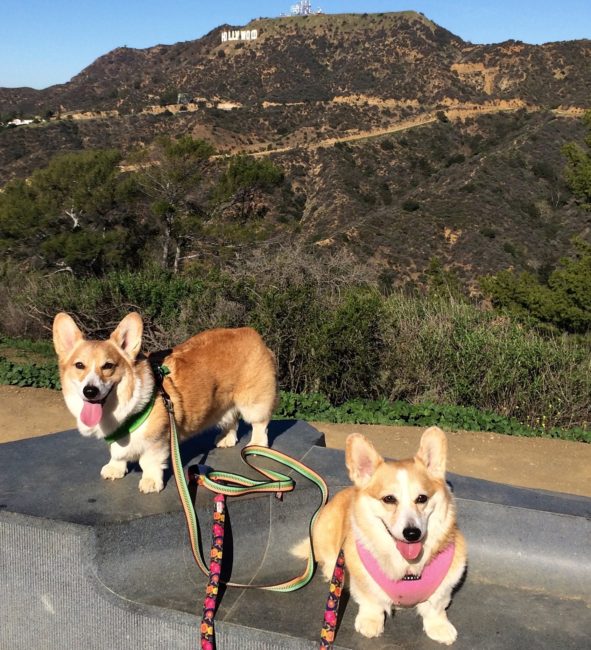 …and then gaze back toward the observatory.
…and then gaze back toward the observatory.
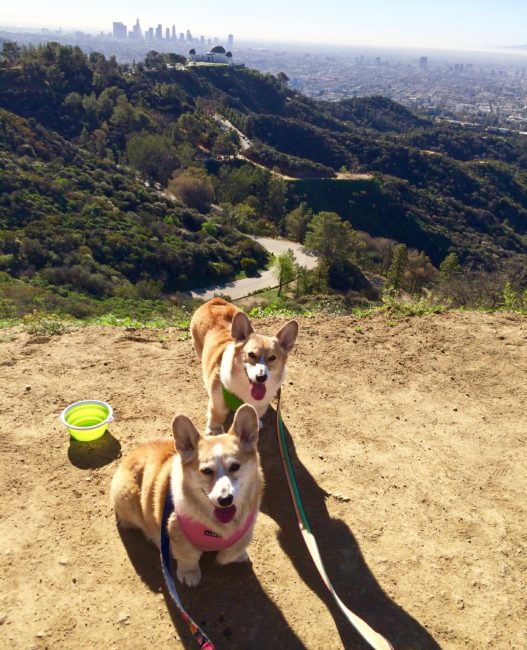 Frankie and Remi usually tell us when it’s time to turn around. Those short legs can only travel so far.
Frankie and Remi usually tell us when it’s time to turn around. Those short legs can only travel so far.
For a free experience (except for parking and the show), there are not many better places to visit than the historic Griffith Observatory. You can take a hike and explore the planets all in one afternoon. It is the true star trek and a place you should scope out.
Griffith Observatory
2800 East Observatory Road
Los Angeles, CA 90027
Phone: 213.473.0800
Hours: Tuesday – Friday 12 p.m. to 10 p.m.
Saturday – Sunday 10 a.m. to 10 p.m. • Closed Monday
Cost: Free (except show tickets, which are $3 to $7)
Parking: $4 per hour during observatory hours
Public Transportation can be an easier way to get here.
griffithobservatory.org
http://www.griffithobservatory.org/visiting/directions.html

